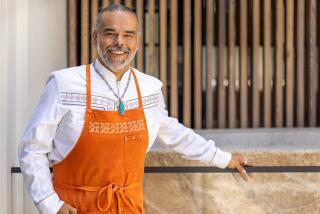GO FOR THE BURN : But Find the Flavor in Hot and Spicy Dishes, Some So Fiery You Should Exercise Caution
- Share via
Most of the world likes to spice up its food, though some regions spring more readily to mind than others. The cuisines of India and Ethiopia, for instance, are largely dependent on crushed spice mixtures called masala (India) or berbere (Ethiopia)--magical blends that test a cook’s mettle and set the palate atingle with sensual delights.
These days, Europe is not likely to spring to mind. In the Middle Ages, however, Europe was just as spice-oriented as Ethiopia. That’s why Columbus went sailing, after all--to get a better source of spices. When he returned from the Caribbean, under the impression that he had discovered a route to India, he brought some samples of a local spice that he assumed was (black) pepper. The rest is food history; chilies are now the most widely grown spice in the world.
Being native to the New World, chilies carry special weight this side of the Pacific Rim. When Southern Californians say “make it spicy,” we usually mean “make it hot.” In this case, hotness is defined not in degrees of temperature but in Scoville units, according to a test devised by an American food chemist back in 1912.
The Scoville test measures pungency in terms of how much water you can add to an alcohol extract of chili and still detect the burn when you taste it; the more dilutable it is, the more concentrated its hotness must be. A Scoville rating of 100 (a pretty paltry rating--down there in the bell pepper league) means that you can still barely taste pepperiness when you dilute a sample with 100 times its volume of water. Some testers have given the Caribbean’s ferocious Habanero pepper ratings as high as 100,000 Scoville units.
There are, of course, many physiological sensations hot foods cause us: flushed skin, a numbing, burning rush in the mouth, a pounding heart. Chilies stimulate the pain-masking chemicals called endorphins (which are also the cause of the “runner’s high”) and contain massive amounts of vitamins A and C.
And although we know that chili hotness is not the same as temperature, there’s a relationship between the two. We know that chilies make us sweat as if we were hot. It’s less known that they also disrupt our body’s ability to sense the temperature around us.
As a food writer, I’m often asked to name the hottest cuisine I’ve experienced. A broad answer would include Thai, Mexican and south Indian, even if all three are toned down considerably for the American palate and climate. When the catchword is spicy, I think of any cuisine that uses spice prominently, not just hot foods. That broadens the equation to include things on every continent and gives me a whole lot more ground to cover.
So here are some of the spicier encounters I’ve had recently in Orange County restaurants, great dishes that cross a broad spectrum of tastes. Spicy foods are said to have medicinal properties, too. But that’s fuel for a future story.
THE AMERICAS
In the United States, the spicier dishes come from south of the Mason-Dixon line. Chef Russell Armstrong of Trees in Corona del Mar does honor to a Southwest tradition with a dish he calls “kick-ass” black bean chili. The chili comes in an individual-sized crock along with sides of Tillamook Cheddar, purple onions and jalapenos, but it’s chock full of ground meat and pretty terrific without the toppings. Thank Armstrong’s use of cumin, red pepper and grated ginger for that, which makes for one of the most complex versions of this dish anywhere.
Even more celebrated spicy dishes come from the Cajuns of Louisiana. Bayou St. John in Seal Beach is our only bona fide Cajun restaurant, a cozy, antebellum style cafe belonging to fourth-generation N’awlins native John Fagot (pronounce it fah-GO). The specialties here are jambalaya, gumbo and blackened redfish, dishes that result in a dining epiphany when served together, as they are here on the restaurant’s Bayou sampler plate.
The gumbo is a murky, soupy melange of shrimp, crab, ham and chicken and homemade sausage. It derives its name from a West African name for okra, a component of the dish. The restaurant thickens the gumbo with file, dried sassafras root, and spices it up with thyme, bay leaves and cayenne pepper. It tastes earthy and intoxicating. Jambalaya is a rice casserole made with many of the same meats and spices, while the restaurant’s feather-light redfish is coated in a secret mix of hot spices based on (what else?) crushed peppers.
Further south, down Mexico way, spicing gets more complex and intense, almost state by state as you head toward Central America. One of Orange County’s best places to eat Mexican dishes is Taco Mesa, a small patio restaurant owned by Ivan Calderon, a chef formerly with the El Torito chain.
Calderon’s foods taste home-cooked, but it is his terrific salsa bar--the best in Orange County--that really sets the place apart. Don’t miss his fabulous cabbage and leafy cilantro relishes; escabeche , homemade pickled vegetables flavored with garlic and bay leaf; and the brown, red and green salsas, all of which turn a tortilla topped with slow-smoked, oven-cooked pork or marinated shrimp or calamari into a mini-masterpiece. Calderon also uses achiote (also known as annato, a ruddy, full-flavored spice favored in the Yucatan) to braise chicken and grill onions.
Then there is South America, where countries like Brazil, Peru and Chile have their own interpretations on how to spice dishes. Topaz Cafe in the Bowers Museum is currently serving little Chilean pies called caldudas and feijoada completa, the hearty Brazilian bean stew, on Thursday and Friday evenings in conjunction with the museum’s exhibit on Amazonian art.
The caldudas are made from masa cornmeal flavored with achiote . Inside, there is a duck filling aromatic with thyme, oregano, juniper berries, allspice and tarragon. To make feijoada completa , John Sharpe, executive chef for West Coast Productions (the company responsible for Zuni Grill, Diva, Bistro 201 and Kachina), simmers black beans with cumin, coriander, red chilies and chopped cilantro, then piles on smoked ham hocks and garlic sausage. The dish is served alongside white rice, collard greens and sauteed pumpkin.
Trees, 440 Heliotrope Drive, Corona del Mar. (714) 673-0910. Dinner daily, 5 p.m. to midnight.
Bayou St. John, 320 Main St., Seal Beach. (310) 431-2298. Dinner daily, 5 to 10 p.m.
Taco Mesa, 647 W. 19th St., Costa Mesa. (714) 642-0629. Open Sunday through Thursday, 9 a.m. to 10 p.m.; Friday and Saturday till 11 p.m.
Topaz Cafe, 2002 N. Main St., Santa Ana. (714) 835-2002. Lunch Tuesday through Friday, 11:30 a.m. to 4:30 p.m.; dinner Thursday through Friday, 4:30 to 8:30 p.m.; brunch Saturday and Sunday 10 a.m. to 4:30 p.m.
THE MEDITERRANEAN
Despite the spice-mania that once led Europeans to sail all around the world, post-medieval European cooking employs fewer spices than that of the other continents. The spiciest European cooking is found in southern Europe, near the Mediterranean.
How about pizza, as interpreted by a chain called Z Pizza? This creative, multinational pizza parlor takes great, taste-tempting liberties with the form. The chain’s new Baja California pizza, for instance, is a delicious mix of Mexican salsa, red and green pepper, fresh serrano chili and chopped cilantro, while my favorite, a French-inspired creation called Provence Arlesienne, is a tempting mix of capers, garlic, basil, fresh tomato and anchovy filets.
The cooking of another Mediterranean country, Lebanon, embodies the traditions of Turkey and the Arab world. For me, the varied, spice-laden appetizers called mezze represent the pinnacle of this wonderful cuisine. The place to eat them locally is Hassan’s in Newport Beach.
Hassan’s is a cozy little haunt with tables set under wooden trellises, a restaurant where you smell the fragrances of coriander, cumin and garlic the minute you set foot inside. This is a laborious style of cooking.
Kubbeh nayya may be the king of the world’s raw-meat dishes. It’s finely ground lamb infused with sweet basil, hot cayenne, cumin seed and cinnamon, thickened with cooked bulgur wheat. Think of sophia as an undersized lamb pizza, redolent of cinnamon, parsley, black pepper and fresh garlic.
Morocco lies thousands of miles from Lebanon and has quite a different culture. It is nearly impossible for a Lebanese to understand a Moroccan, even though both speak dialects of Arabic. Moroccan cuisine is a whole different idiom too, an epiphany of cumin, coriander seed and cinnamon. For me, the great dish of the cuisine is bestila, a flaky, sugar-dusted pie filled with crushed almonds, chopped chicken and grated eggs.
In Morocco, bestila takes all day to make. It can be up to three feet across and can feed 20 people. Marrakech in Newport Beach serves a heavenly version, hot and steaming, redolent of cinnamon and parsley. Like most Moroccan dishes, it is eaten with the fingers. Bestila might be the world’s most sensual dish. It’s certainly one of its most exotic and delicious.
Z Pizza, 32371 Street of th Golden Lantern, Laguna Niguel. (714) 240-6600. Open Sunday through Thursday, 11 a.m. to 10 p.m., Friday and Saturday till 11 p.m. (There are several other O.C. locations, including franchises in Laguna Beach, Laguna Niguel, Balboa Island and two in Irvine.)
Hassan’s, 3325 Newport Blvd., Newport Beach. (714) 675-4668. Lunch Tuesday through Saturday, 11 a.m. to 3 p.m.; dinner Tuesday through Sunday, 5:30 to 11 p.m.
Marrakech, 1100 W. Coast Highway, Newport Beach. (714) 645-8384. Open daily, 5 to 11 p.m.
AFRICA
The first time I ate Ethiopian food, I bit straight into a hot chili, and my eyes filled with tears. Most Ethiopian dishes are buttery stews of meats and vegetables, seasoned robustly with a generic spice mixture known as berbere. Berbere is the soul of this cooking, the fire, and is usually red hot, thanks to a mix of the very hot “bird pepper” chili, locally known as mitmita , with rue seed, bishop’s weed (an aromatic spice) and lots of cardamom.
At Ras Dashen, even when the food is hot enough to bring tears to your eyes, it’s rarely hot enough for the Ethiopian clientele. All the tables have little shakers of mitmita for those who want to turn up the thermostat. Try doro wat , chicken simmered in a rich, grainy, burnished berbere sauce, garnished with a hard-boiled egg and a side serving of creamy homemade curds ( aib ) that cool down the mouth as fast as the chicken heats it up. The hottest dish in the house, zighni , is strips of sauteed lamb or beef in a forebodingly shiny red berbere sauce. Get out your handkerchiefs.
Ras Dashen, 12549 Harbor Blvd., Garden Grove. (714) 638-4260. Open daily, 10 a.m. to 11 p.m.
ASIA
Nearly all of us associate Asia with spicy food, and rightly so. Most Asian countries except Japan use a multitude of spice in their kitchens. Even way up north in Korea, the food is shot through with red chili and garlic, making it the only cold-weather country in the world with a hot and spicy cuisine.
But it is Thailand and India where spices are elevated to the highest art forms. At Buena Park’s Thainakorn, Orange County’s best Thai restaurant, you get a nose full of lemon grass, galanga root, lime leaves and prik khi nu --one of Asia’s hottest chilies--the moment you enter.
So popular is this restaurant with area Thais that it has nearly tripled in size since it first opened. Most of the customers come to eat Isaan dishes, the blistering hot fare of the Thai northeast, that include sai gaw (Thai sausage with sticky rice), som tam (green papaya salad with dried shrimp), larb pet (ground duck meat with lime leaves), and prik khi nu .
These dishes are not found on the restaurant’s English menu, by the way. You order them verbally, or from a Thai language blackboard located near the front door. They are each hot enough to make the uninitiated gasp for breath, and break into a beady sweat.
Most of our Indian restaurants rely on masalas (spice mixtures) to flavor their meats and vegetables. In the familiar north Indian-style restaurants, the flavors of ginger, turmeric, garlic and a fair bit of cumin are invariably present.
But the vegetarian cooking of south India is totally different, thanks to the use of green chili, tamarind, coconut and mint, omnipresent in these dishes. Cerritos is home to Mahdu’s Dasaprakash, California’s best south Indian restaurant. At Mahdu’s, rice and lentils are combined with these and other spices in seemingly infinite ways to produce dishes like the tube-shaped lentil pancake called masala dosa , the crunchy fritters called vadai and the flying saucer-shaped rice cakes known as idlis .
These and other dishes are accompanied by tamarind lentil broths varying in intensity and a variety of spicy chutneys. Oh, by the way, if the Thais or south Indians at these places are actually convinced you want it hot , set that cellular phone to 911 just in case.
Thainakorn, 8674 Stanton Ave., Buena Park. (714) 952-4954. Open Monday through Thursday, 10:30 a.m. to 10:30 p.m., Friday and Saturday till 11 p.m.
Mahdu’s Dasaprakash, 11312 E. 183rd St., Cerritos. (310) 924-0879. Open Tuesday through Sunday, 11:30 a.m. to 9:30 p.m.
More to Read
Sign up for The Wild
We’ll help you find the best places to hike, bike and run, as well as the perfect silent spots for meditation and yoga.
You may occasionally receive promotional content from the Los Angeles Times.






